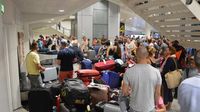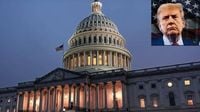As the U.S. government shutdown trudges into its third week with no end in sight, the effects are rippling far beyond the marble halls of Washington. From crowded airports to dinner tables that may sit empty this Thanksgiving, millions of Americans are feeling the squeeze as political gridlock threatens to upend daily life in dramatic ways.
On October 19, 2025, Chris Sununu, the newly appointed CEO of Airlines for America and former New Hampshire governor, had a simple message for travelers: “Pack your patience.” Speaking to NewsNation’s Chris Stirewalt, Sununu acknowledged the mounting delays at airports across the country, but reassured the public, “People should still plan on having their flights. But we always say, pack your patience, give yourself a little more time.” According to flight-tracking site FlightAware, a staggering 5,200 flights within, into, or out of the U.S. were delayed that Sunday, with nearly 100 cancellations. The previous day saw even more disruption: over 5,700 delays and more than 320 cancellations. While it remains unclear how many of these were directly linked to staffing shortages, the numbers paint a picture of a system under strain.
The strain is, in large part, a consequence of the government shutdown that began on October 1. Air traffic controllers and Transportation Security Administration (TSA) agents are still on the job—but now, they’re doing it without pay. As Transportation Secretary Sean Duffy told Fox Business on October 9, the average share of delays caused by controller shortages skyrocketed from 5 percent before the shutdown to 53 percent during it. It’s a sharp uptick that’s left travelers frustrated and airlines scrambling to keep schedules intact.
Despite the chaos, Sununu urged Americans not to cancel their Thanksgiving travel plans. “We’ll see where it goes, some slight delays across the country,” he said. “May increase a little bit this week, but overall there’s no cancellations [due to shortages] and safety is absolutely paramount.” For now, the message is clear: expect inconvenience, but not disaster—at least not yet.
But for millions of families, the stakes are far higher than missed connections or long security lines. With Thanksgiving fast approaching, the shutdown’s impact on the Supplemental Nutrition Assistance Program (SNAP)—the country’s largest anti-hunger initiative—could mean empty plates for many. On October 16, Agriculture Secretary Brooke Rollins sounded the alarm, warning that SNAP, which supports 42 million Americans, will face a funding shortfall in just two weeks if the shutdown continues. “So you’re talking about millions and millions of vulnerable families, of hungry families that are not going to have access to these programs because of this shutdown,” Rollins told reporters at the White House. She later took to social media, blaming Democrats for putting “their political agenda ahead of food security for American families.”
Democrats, for their part, shot back, accusing Republicans of blocking a deal to extend expiring Obamacare premium subsidies—a central point of contention in the budget standoff. The U.S. Department of Agriculture (USDA) has already warned states that if federal funding lapses continue, there won’t be enough money to deliver full food stamp benefits in November. States have been asked to postpone next month’s payments until further notice. The program’s $6 billion contingency fund falls short of the $8 billion needed for November payments, and as the days tick by, the gap grows more urgent.
The fallout is immediate: at least 17 states are preparing to halt new SNAP applications, and some are scrambling to find creative ways to stretch limited resources. New York Governor Kathy Hochul criticized the Trump administration for instructing states to stop regular monthly disbursements, calling the move reckless as the holiday season nears. This isn’t the first time SNAP has been threatened during a shutdown—back in 2018, emergency measures kept the program afloat for a time—but the current deadlock feels particularly dire with Thanksgiving looming on November 27.
Meanwhile, the political showdown in Washington shows little sign of resolution. As of October 17, the shutdown had dragged on for 17 days, and analysts are warning it could stretch to a record-breaking 41 days—possibly lasting until Thanksgiving itself. According to Beacon Policy Advisors, “An end to the shutdown requires either White House engagement on a deal or Democrats to cave. As of now, there are no signs of either.” The standoff centers on a dispute over funding legislation, particularly the extension of Obamacare subsidies, with both sides digging in their heels. Ironically, polling suggests voters blame both parties for the impasse, a dynamic that may actually prolong the stalemate as neither side feels pressured to compromise.
There are other flashpoints, too. The White House recently redirected $8 billion from military research and development funds to ensure active-duty servicemembers received their October 15 paychecks—a move that raised eyebrows about its legality but averted a potentially explosive crisis. Still, more than 4,100 federal workers have received layoff notices, with projections that over 10,000 jobs could ultimately be at risk. A federal judge granted a temporary restraining order blocking some of those layoffs, but uncertainty lingers for thousands of families.
Economists are keeping a close watch on the broader fallout. Most estimate that each week of the shutdown shaves 0.1% to 0.2% off U.S. economic growth. While that might seem minor against a robust 3.8% GDP growth in the previous quarter, the cumulative effect is nothing to sneeze at—especially if the shutdown stretches into November as many now fear. Independent economist Ethan Harris warned that this shutdown “will have more lasting impacts as it hits an already vulnerable economy.”
For everyday Americans, the consequences are becoming impossible to ignore. In a MarketWatch poll, 47% of respondents said their biggest concern about the shutdown was its potential to hurt the economy, ahead of worries about travel or furloughed workers. And as the holiday season draws near, the prospect of delayed flights, unpaid federal employees, and millions facing food insecurity is casting a long shadow over what should be a time of gratitude and togetherness.
With both sides in Washington locked in a high-stakes game of chicken, the country is left waiting—sometimes in airport terminals, sometimes in food pantry lines, and always with a sense of growing unease. Whether the political will to end the shutdown emerges before Thanksgiving remains to be seen, but for now, Americans are bracing for a holiday season unlike any in recent memory.

